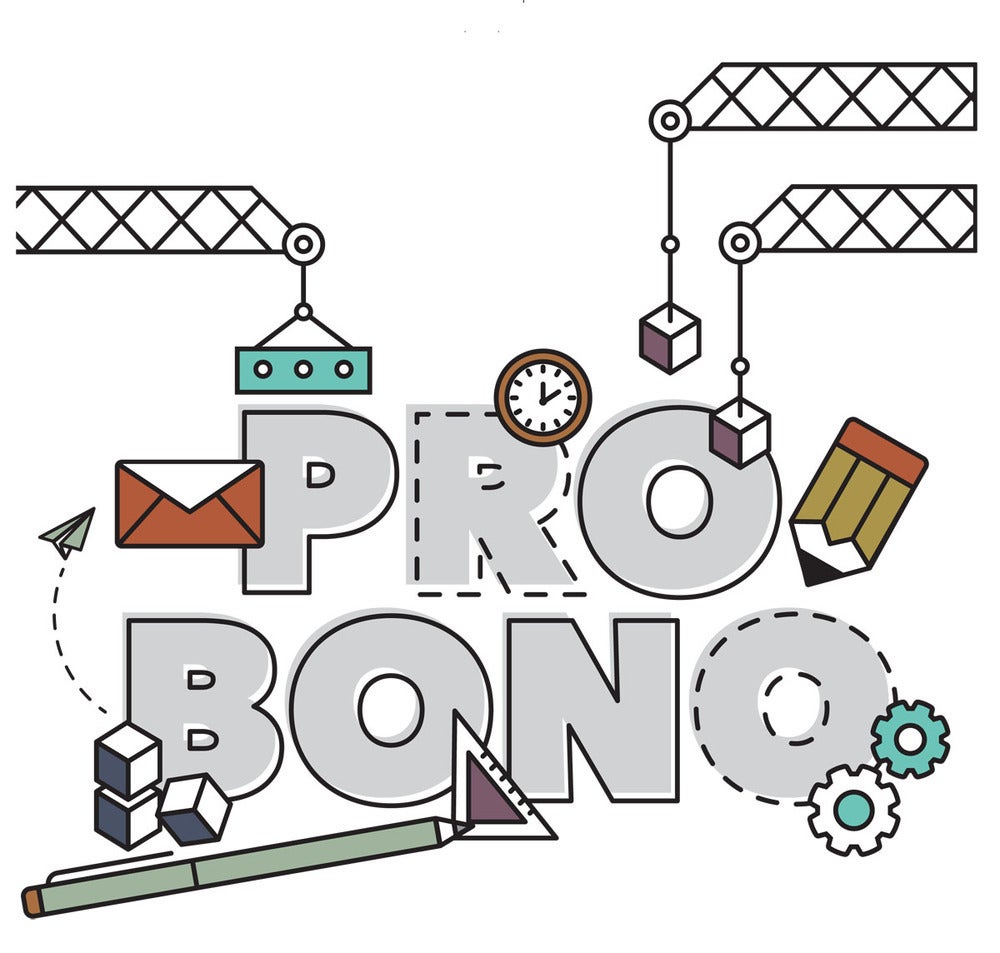
CHEAT SHEET
- Get buy-in. Gathering support from executives is critical to starting a pro bono legal program, from budgetary assistance to lending credibility.
- Find partners. Contact local bar associations, law firms, and legal aid societies. These organizations may already have programming you can become involved with and insurance and record requirements you might need.
- Be realistic. When considering the scope and size of pro bono projects, start small with volunteers and plan to scale up.
- Keep it going. After each event, share photos or a write up to showcase your work and maintain interest. Think of the projects as opportunities for recruiting and retaining volunteers.
For the past several years, I have been involved in the Boy Scouts of America as an adult leader and volunteer for both of my children’s troops, and one of the many tenets I have come to appreciate is “Leave No Trace.” The idea behind this is to go camping and then leave the spot exactly as you found it — or even better than you found it — picking up any trash left by others and making sure it is in good shape for the next campers. Creating an in-house pro bono program requires a similar approach: Leave the world in better shape than we have found it. Taking time out of your busy in-house practice may seem impossible, but with advance preparation and some tips and tricks, anyone can start a pro bono program quickly and easily.
It’s much easier to partner with a law firm, legal aid society, or bar association to get started quickly. There are many programs that exist and law firms love to involve their clients in programming.
I know this to be true because I started a pro bono legal program at Salesforce in August 2014 and ran the program for four years. We had a large, globally dispersed department, and while Salesforce had a robust employee volunteer program, not much was being done in the way of skills-based volunteering at that time. The challenge was to figure out the best way to create a meaningful program for lawyers and paralegals in the department, and the most effective way to get people involved either on a local or global basis. To determine the best way to do this, we drafted a survey and sent it out to the department to gather input on interests and ideas. Once we received that information, we created a committee to parse out the work.
Get buy-in
In addition to surveying your organization, getting buy-in from the top is critical to kicking off any new program. I met with Chief Legal Officer Amy Weaver, who became the executive sponsor of our pro bono program effort. Her buy-in was crucial; she gave us instant credibility with the rest of the department and provided a small budget. Once we were up and running, she also attended several events to show her support, which provided meaningful opportunities for our pro bono volunteers to work with her on projects. Additionally, to drum up more interest, she agreed to add a quarterly award to her award roster — the “Scales of Justice” award. Getting nominated for any department award allowed team members to receive recognition for a job well done, and having a pro bono award definitely raised the profile of the program.
5 tips for starting a pro bono partnership at your organization
HOW CAN YOU GO ABOUT CREATING A SIMILAR PRO BONO IN-HOUSE PROGRAM?
Finally, remember you can have fun all while making the world a better place.
- GAUGE INTEREST. Determine how many people are interested in the program and give someone interested in leadership the opportunity to take on the project.
- SURVEY THE DEPARTMENT. That way, you will see what types of programs people want to work on and the type of work they want to find.
- GET BUY-IN. An executive sponsor will help with budgets and credibility.
- CONNECT WITH LOCAL BAR ASSOCIATIONS AND LAW FIRMS. They already have established programs and connections to other community groups.
- SET REALISTIC GOALS. Start with one program and build on that over time.
Connect with local bar associations
The next step we took was to contact our local bar association. We worked with the San Francisco Justice and Diversity Center to establish a program to support veterans in conjunction with Veterans Day 2014. “Service-4-Service” was a one-day event created to provide free legal and social services to US veterans who met the eligibility criteria outlined by the Veterans Court calendar. Created through the collaboration of a wide range of agencies and organizations, including Salesforce, the Community Justice Center, Swords to Plowshares, and the law firm of Farella Braun and Martell, the event was a success and allowed us to gain momentum with our first program.
From there, we partnered with law firms and other legal aid societies to do all kinds of different projects, both on a local level as well as large global research projects. Within the second year of running the program, we worked on a project with Baker & McKenzie in connection with the Consortium for Street Children, along with other clients of Baker. This corporate partnership was recognized by American Lawyer at its Annual Global Legal Awards as Pro Bono Research Project of the Year in 2016.
Find a partner
It’s much easier to partner with a law firm, legal aid society, or bar association to get started quickly. There are many programs that exist and law firms love to involve their clients in programming. The benefit of this approach is that these organizations provide insurance for the programming and also provide any attorney of record requirements. ACC has also partnered with Corporate Pro Bono (www.cpbo.org), an organization that has tasked with aiding corporate legal departments to get started with pro bono programs. They have a great amount of knowledge and can answer questions that you have when you formulate a program.
Set realistic goals
Next, develop a pro bono policy and goals for your programs. One goal might include determining how many pro bono projects can you reasonably support? If you are a large department with people in multiple cities, it probably makes sense to roll out your program at your headquarters, or where you have the largest contingency of department members. Later, you can add cities or do national or global pro bono projects; better to start small and scale up than spend time and effort to manage the logistics of an unwieldy project. Like any other program, you’ll need resources. Again, this is where buy-in from the top is helpful — if you can secure a budget before your program kicks off you are ahead of the game. Determine if the program will be entirely voluntary or will require everyone to do a certain number of hours. Often, starting off as a voluntary effort makes sense, and you can grow the program from there. If you have a Volunteer Time Off (VTO) policy for general company volunteerism, and at least 25 percent of companies today do, then you can determine if the pro bono hours can count toward the VTO hours as well.
Even as you are starting your program, make sure it is inclusive, so everyone in the department can be part of the program. Be sure to include non-lawyers who might want to be involved. Many projects can be done by paralegals and administrators with the oversight of lawyers. Even projects that require lawyers may need organizational help, notarizations, and more.
Getting people excited
Often people have good intentions to take part in a pro bono program but aren’t sure they have time. Others are nervous about not being an expert in the area of law you are working on for the project. These are all solvable problems. To start, selling the personal benefits of the program to the lawyers is an effective means to encourage their involvement. For example, working on pro bono activities allows lawyers to try out new skills: A corporate lawyer can work on a litigation matter, make an appearance in court, write briefs, and do things they wouldn’t otherwise have a chance to do. This may be an opportunity for that lawyer to try something new that they are interested in experiencing or just allow them to try new skills even if they don’t plan to use them in their daily law practice. For those more nervous about not knowing how to do the work, make sure you partner with organizations who are committed to training your staff and being on hand for the duration of the program for additional questions.
Once you have a plan for your first pro bono activity, make a day of it. You can do a CLE for training either the same day or beforehand. When you conduct the pro bono program, make sure to have your beneficiaries in attendance and provide lunch or other food if possible. Afterward, you can do a happy hour with the legal aid society or law firm.
Often people have good intentions to take part in a pro bono program but aren’t sure they have time. Others are nervous about not being an expert in the area of law you are working on for the project. These are all solvable problems. To start, selling the personal benefits of the program to the lawyers is an effective means to encourage their involvement.
For example, at Salesforce, we decided to hold an immigration clinic for eligible DACA (Deferred Action for Childhood Arrival) recipients. The beneficiaries all had long drives or com-mutes into San Francisco, so we wanted to make it a special day for them.
Before the day of the event, the paralegals in our department sent out administrative information on how to make sure we would all be hooked up to the printer in the other building where we were holding the program. Next, we created separate roles for them on the day of the event so they could run back and forth to the printer without having to wait to sign forms once they were printed.
On the day of the program, the lawyers arrived about an hour before the beneficiaries in order to receive training by the legal aid society on how to fill out the DACA forms online. There were a lot of different government requirements for us to comply with; having the legal aid lawyers there to walk us through the process helped everyone feel confident that we could do the work well. This helped ease any concerns and made things run smoothly.
Next, we worked with an employee resource group to find Salesforce employees outside the legal department who could serve as Spanish translators. We also held a panel of employee speakers who talked about their own story of being an immigrant in the United States and how they came to eventually work at Salesforce. A member of the legal department emceed the panel in Spanish and English. One of the panel members had been a DACA recipient and talked about how his life was forever changed by his acceptance into UC Berkeley with a scholarship, and eventually landing a job at a technology company. We also made food and drinks available for all participants.
Additional resources
- The American Bar Association has a directory of pro bono organizations organized by state. (www.americanbar.org/groups/probono_public_service)
- Probono.net aggregates different opportunities by state (www.probono.net/oppsguide).
- Connect with your local ACC Chapter to find volunteer opportunities near you (www.acc.com/chapters-networks).
We spent the next few hours filling out the forms and finalizing all the paperwork necessary to send off each DACA hopeful with a final packet of papers that were ready to file. Some of those in the room needed renewals, which were easier to process, while others were new cases. Most of the kids were in high school and came with one or both parents, and not all could speak English fluently. Having our translators available to work with us in filling out the required information in English was very helpful.
After all the DACA kids were on their way with their completed paperwork in hand, we cleaned up the room to celebrate our accomplishment in helping others and showing the kids that anything is possible for them.
After the event
After each pro bono event, we also made sure to showcase what we were doing for the rest of the company and for the benefit of other legal departments. We created a blog post for most events and worked with our PR team to post them on the company website. We used the program as a retention tool for our lawyers and for career development in leading new programs. Each summer when the new class of interns arrived, we built a program around their time in our department and many talked about the pro bono program as one of the highlights of their summer.
Once you have done one successful pro bono program, don’t stop there. You can keep planning more, and by the end of your first year, you will have accomplished so much.
I’m proud to say that at Twilio, the company I joined in fall 2019, we are starting our own pro bono program and have already established a committee. Although we began this process while we were sheltering in place, we found an opportunity for pro bono work that we could do virtually with a goal to move forward with in-person events when able.
So, get to work on your pro bono program to make the world a better place: Be inclusive, get buy-in from your general counsel, and be clear from the start about the goals you want to accomplish. Then, you can stand back and see the difference your team will have made in others’ lives.
ACC EXTRAS ON… Pro bono programs
ACC Docket
How Legal Ops Can Advance In-house Pro Bono (Jan. 2020).
Article
How Australian Employers Can Help in (and after) the Bushfire Crisis (Jan. 2020)
ACC HAS MORE MATERIAL ON THIS SUBJECT ON OUR WEBSITE. VISIT WWW.ACC.COM, WHERE YOU CAN BROWSE OUR RESOURCES BY PRACTICE AREA OR SEARCH BY KEYWORD.



